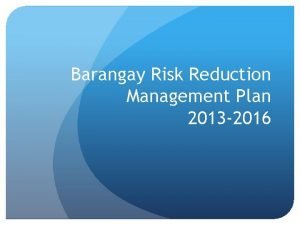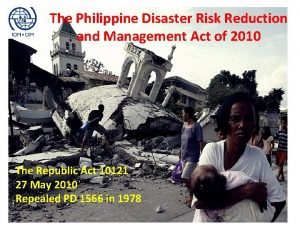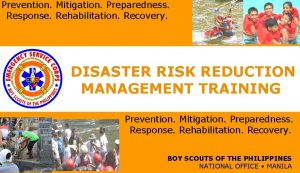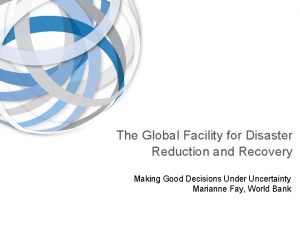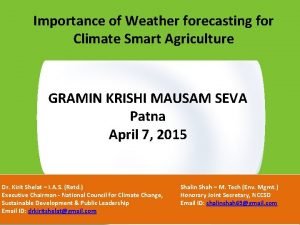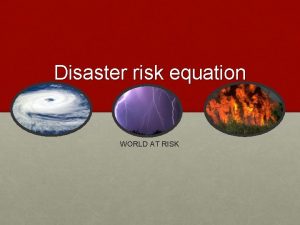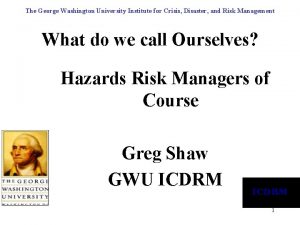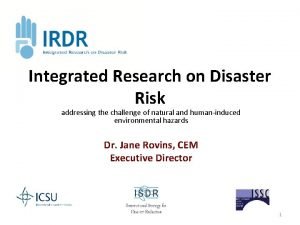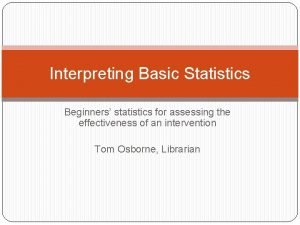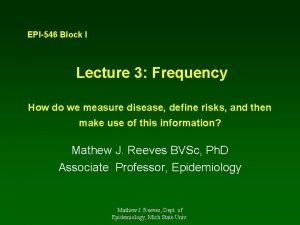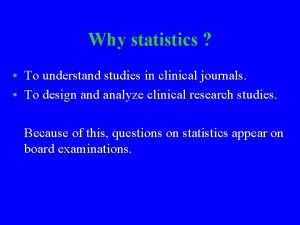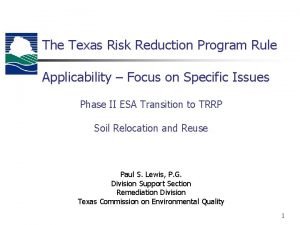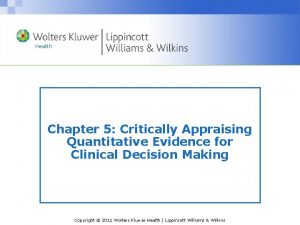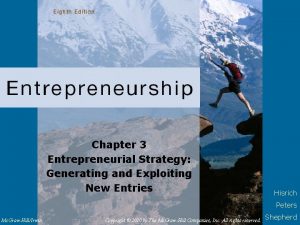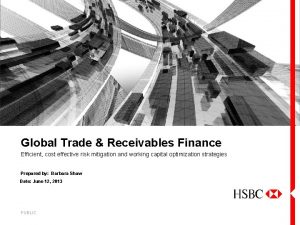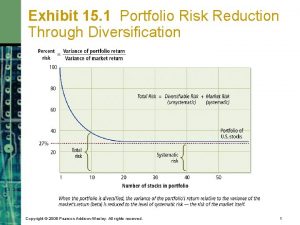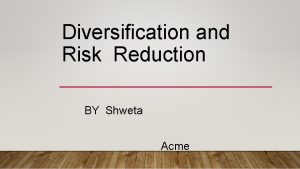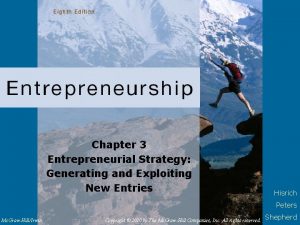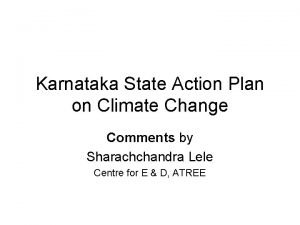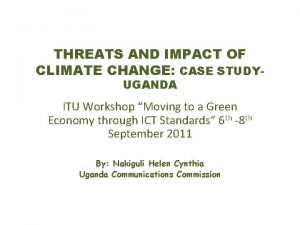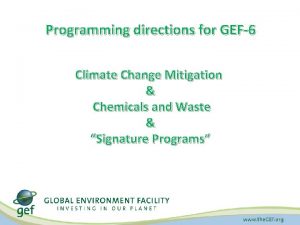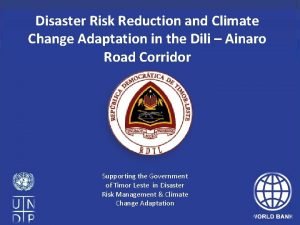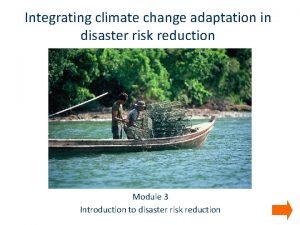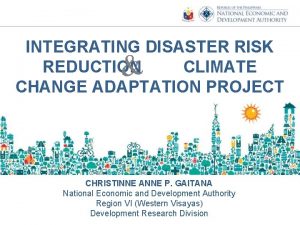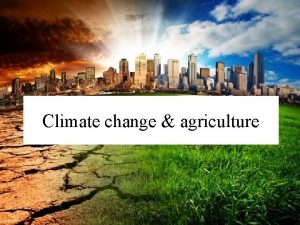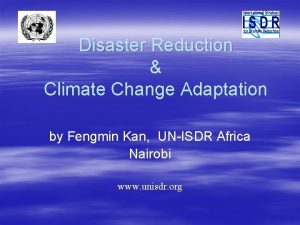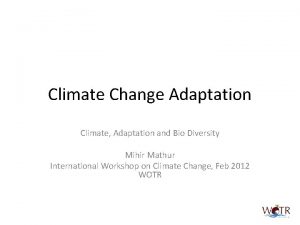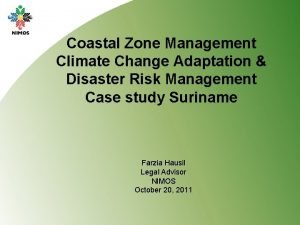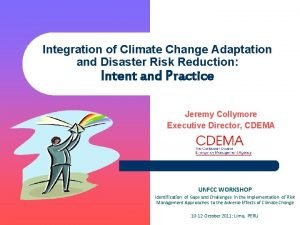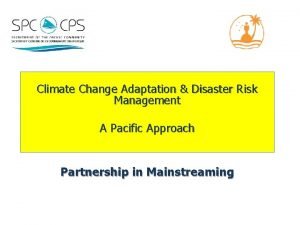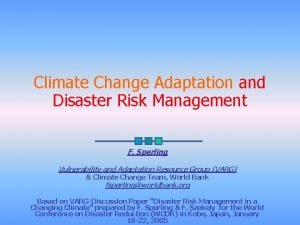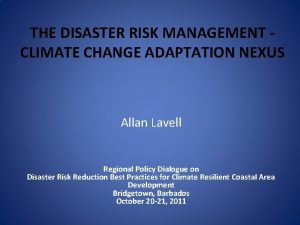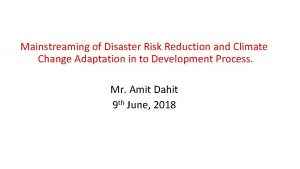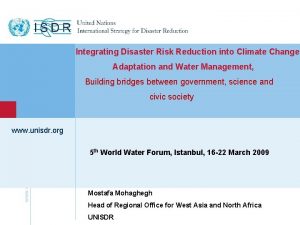Climate Change Adaptation Disaster Risk Reduction in Agriculture




































- Slides: 36

Climate Change Adaptation & Disaster Risk Reduction in Agriculture – An International Perspective & Examples - Dr. Stephan Baas; Dr. Claudia Hiepe FAO, Rome, Italy

Structure of Presentation • Overall context for CCA & DRR in agriculture • FAO framework programmes on CCA & DRR • Examples on long-term climate change adaptation • Integrated approach to disaster risk reduction in agriculture and examples • Lessons

Two Major Global Challenges 1. Achieving Food Security – 1 billion hungry, +3 billion people by 2050 – Increased demand for food, feed and fibre • need for 70% food production increase by 2050 2. Combatting Climate Change – ” 2 degree goal” requires major emission cuts – Agriculture most climate sensitive/vulnerable – Urgent need to adapt, DRR first line of defense – Agriculture and Land use =1/3 of emissions CCA & DRR crucial for Sustainable Agriculture and Food Security

Climate change threatens food security

More frequent climate-related disasters Biological Geological Climate-related disasters

Disaster Risk Reduction & Management for FNS Prevention Mitigation Preparedness Response Rehabilitation Major hazard/disaster Transition rowth ic/social g Smaller hazard/disaster conom normal e DRR initiatives DRR initia pattern D np RR i lace h wit s t ac mp rd I a z a H ives ithout Hazard Impacts w Media response itiat DRR in

Disaster Risk Reduction & Management for FNS Prevention Mitigation Preparedness Major hazard/disaster DRR initiatives Response Rehabilitation Transition ? ? ? • DRM as first line of defense to increase resilience against CC impacts Media response • In developing countries, Agriculture is at the center of DRR and CCA • Increasing convergence CCA & DRR agendas

International to local divide Global Objectives WSFS “Calories” UNFCCC “Carbon” UNISDR “Disasters” UNCCD “Soil” +Biodervisty, Human rights, Health, Trade, Education, . . . National International Food Security National Local Climate resilience Disaster Resilience Sustainable land management

II. FAO Frameworks for CCA & DRR FAO-Adapt DRR Framework Programme

Core Principles of FAO’s Adaptation Work Focus on food security Mainstream CC into development Ensure country-driven processes Employ ecosystem-based approach Ensure trans-boundary collaboration Ensure participatory, gender-sensitive, location-specific adaptation • Deliver through partnerships and as one UN • Take long-term programmatic approach • Promote synergies between adaptation, mitigation and productivity increase (climate-smart agriculture) • • •

FAO Medium-term Priorities for Adaptation

Long-term Adaptation - Towards Climate. Smart Agricultural Landscapes Transform agriculture to enhance the achievement of national food security and development goals in the light of global challenges

Long-term Adaptation: Agro-ecological Changes “Most countries climate will become more similar to another countries climate, thus increasing interdependance and need for cooperation. “ updated AEZ methodology Kagera Agro-ecosystem Management Project Uganda in-/ex-situ biodiversity conservation Tanzania Rwanda Burundi

MDG-F Project: Climate Change & Env. Window • FAO involved in 16 national programmes under MDG-F CC & ENV window 14

Linkages climate change & disaster risks Ø Climate change increases the frequency and intensity of disasters; Ø Disaster risk reduction is a natural entry point for CCA Ø DRR institutional structures exist in most countries to build on.

Multiple Threats to Agricultural Livelihoods DRR/M in Agriculture includes more than climate induced hazards All natural disasters Protracted Crisis Food chain emergenci es Social and economic crisis Climate change => will impact on all above

FAO DRR Framework Programme CROSS-CUTTING PRIORITIES Knowledge, innovation & education to build a culture of resilience

1/ ENABLE THE ENVIRONMENT: Institutional strengthening & good governance for DRR in agricultural sectors. • Legal and policy frameworks • Institutional structures and coordination • Capacity development and local support • Communication strategies & knowledge sharing for DRR

1/ ENABLE THE ENVIRONMENT: MINISTRY OF AGRICULTURE AND FISHERIES BELIZE PLAN OF ACTION for DISASTER RISK REDUCTION In Agriculture AUGUST 2011

2/ WATCH TO SAFEGUARD Early warning systems and DRR related databases EMPRES: Cassava diseases have an immediate impact on food security Diseased cassava GIEWS: Soaring market prices Flood early warning Databases: FAOSTAT, AQUASTAT, Fish. STAT, Forest. STAT, Price. STAT

3/PREPARE TO RESPOND Strengthen capacities in preparedness to improve response to and recovery from shocks and their impact on FNS, for example: AGRICULTURE §Seed, grazing fodder reserves §Safe storage facility for seeds, harvests, tools §Protection of food processing facilities Seed reserves Storage facility, Burundi

3/PREPARE TO RESPOND Strengthen capacities in preparedness to improve response to and recovery from shocks and their impact on FNS AGENCY PREPAREDNESS §Standard Operating Procedures (SOPs) for FAOs’ preparedness and response to agricultural mega emergencies

3/PREPARE TO RESPOND Strengthen capacities in preparedness to improve response to and recovery from shocks and their impact on FNS FISHERIES • Preparedness guidance/best practices in specific fisheries and aquaculture emergencies • Safety at sea training and guidance

3/PREPARE TO RESPOND Strengthen capacities in preparedness to improve response to and recovery from shocks and their impact on FNS FORESTRY §Forest fire management preparedness plans/ training §Awareness & preparedness measures of land slides in catchment area Mgt Watch towers Forest fire management training in Nicaragua Awareness and preparedness measures of landslides – landslide in Pakistan

4/ BUILD RESILIENCE. Mitigation, prevention and building resilience with technologies, approaches and practices in all agricultural sectors Agriculture §Conservation agriculture §Crop diversification §Appropriate crop selection (drought/saline/flood tolerant) §Adjust cropping calendars §Local seed multiplication systems Water §Rainwater harvesting, conservation & storage §Water reserves to buffer droughts Livestock Fisheries §Fodder conservation §Proofing of storage facilities and livestock shelters. §Resilient animal breeding §Pest management to cope with threats §Adoption of ecosystembased approach §Implementation of the Code of conduct for responsible fisheries §Sustainable livelihoods approaches/diversification §Support to the development of financial mechanisms, such as insurance Land Forests §Restoration of degraded lands §Land use/access, tenure & territorial planning §Land soil management §Forest pests prevention §Agro-forestry §Integrated Fire Management §Afforestation /reforestation §Catchment area Mgt

4/ BUILD RESILIENCE . Mitigation, prevention and building resilience with technologies, approaches and practices in all agricultural sectors Agriculture §Conservation agriculture §Crop diversification §Appropriate crop selection (drought/saline/flood tolerant) §Adjust cropping calendars §Local seed multiplication systems Conservation agriculture Crop diversification Drought tolerant maize variety

4/ BUILD RESILIENCE . Mitigation, prevention and building resilience with technologies, approaches and practices in all agricultural sectors Livestock §Fodder conservation §Proofing of storage facilities and livestock shelters §Resilient animal breeding §Pest management to cope with threats Rice straw management and conservation, Egypt Shelter for sheep, West Bank and Gaza Strip Biosecurity to control spread of Transboundary Animal Diseases, Poultry wholesale market, China

4/ BUILD RESILIENCE . Mitigation, prevention and building resilience with technologies, approaches and practices in all agricultural sectors Land §Restoration of degraded lands §Land use/access, tenure & territorial planning §Land soil management Water §Rainwater harvesting, conservation & storage §Water reserves to buffer droughts § Drainage and irrigation management Soil fixation to reduce land degradation, Burkina Faso Drainage improvement in Juye , Shandong Province, China

Think global – act local: triggering location specific actions • Assess current vulnerability, risks and local livelihoods Assess future climate risks h ke Sta • Promote institutional capacities for DRR and CCA • Identify, validate, test location specific GP options Action in the Field. . . • nt me ge ga En er old • • Agronomic management • Enterprise/income diversification • Strengthening local institutions • Action research , on-farm testing Design location-specific DRR/CCA strategies • Up-scaling and mainstreaming

Community–based Disaster Risk Reduction Demand responsive intervention design : Juye (China) • • Farmers cooperatives capacitated as partners in DRR/CCA Early warning system and information dissemination mechanism Drainage and irrigation infrastructures improved Dissemination of newly released hazard tolerant wheat and cotton varieties Formulated fertilization for soil improvement Gender mainstreaming Disaster risk management plans (villages & county) developed and included into overall development planning http: //www. fao. org/climatechange/china/juye/en/

Community–based Disaster Risk Reduction

DRR Projects in the Caribbean Belize , Cuba, Grenada, Domenia, Haiti, Jamaica, St Lucia Good practice identification & replication n Support to sectoral planning for DRR/CCA n Inter Country Learning exchange n Documentation: TECA data base n http: //www. fao. org/teca

Training Packages for CCA and DRR/M • E-learning tool Planning for Community. Based Adaptation to Climate Change • Training package on DRM systems analysis • E-learning module: "Climate Change and Food Security“ • The Ex Ante Carbon-balance Tool • Gender and Climate change

Lessons I n Food security perspective: DRR & CCA go together; n Agriculture provides opportunities to link sustainable production, adaptation and mitigation targets (climatesmart agriculture) n DRR is a suitable entry point to initiate CCA processes at local levels n Cross-sectoral perspective is essential; catalyze buy in !! n Address DRR/CCA within broader vulnerability and development context;

Lessons II n There are no “one fits all” practices, plan context specific; farmers take today only what benefits them but framework conditions may change n Doing better on known sustainable land water management practices (no-regret) n Re-strengthen the role of research, R&D linkages and extension services (for poor) n Action research & iterative planning along agricultural seasons (not in decades as for CC); mutual learning; M&E and documentation are key; n Urgent need for more reliable seasonal weather forecasting coupled with season-specific advice on crop selection and water management n Community-based DRR and adaptation are suitable to promote mainstreaming of adaptation in AG sectors

Lessons III Constraints for implementation of CCA & DRR: n inadequate data and institutional capacity n limited financial resources n scattered intra- and interregional cooperation for monitoring, policy development, research and capacity development THANK YOU! SALAMAT PO!
 Climate change 2014 mitigation of climate change
Climate change 2014 mitigation of climate change Bdrrm plan message
Bdrrm plan message Philippine disaster risk reduction and management act
Philippine disaster risk reduction and management act National disaster risk reduction and management framework
National disaster risk reduction and management framework Risk avoidance
Risk avoidance Liquidity measures
Liquidity measures Socio economic trends
Socio economic trends Importance of weather and climate to agriculture
Importance of weather and climate to agriculture Equation of disaster
Equation of disaster George washington crisis management
George washington crisis management Integrated research on disaster risk
Integrated research on disaster risk Wsjf alternatives
Wsjf alternatives Interpreting relative risk
Interpreting relative risk Number need to treat
Number need to treat Risk reduction strategies for new entry exploitation
Risk reduction strategies for new entry exploitation Relative risk reduction formula
Relative risk reduction formula Texas risk reduction program
Texas risk reduction program Relative risk reduction formula
Relative risk reduction formula Risk reduction strategies for new entry exploitation
Risk reduction strategies for new entry exploitation Global trade and receivables finance
Global trade and receivables finance Risk reduction through diversification
Risk reduction through diversification Risk reduction through diversification
Risk reduction through diversification Tceq trrp
Tceq trrp Generation of new entry opportunity
Generation of new entry opportunity Climate change paragraph
Climate change paragraph Karnataka state action plan on climate change
Karnataka state action plan on climate change Brainpop ocean currents
Brainpop ocean currents Climate change meaning and definition
Climate change meaning and definition Chapter 13 atmosphere and climate change section 1
Chapter 13 atmosphere and climate change section 1 Unit 9 climate change
Unit 9 climate change Conclusion of climate change
Conclusion of climate change Conclusion of climate change
Conclusion of climate change Conclusion of climate change
Conclusion of climate change Mathematics of climate change
Mathematics of climate change Climate change definition ap world history
Climate change definition ap world history Climate change mitigation
Climate change mitigation 414 climate change
414 climate change

